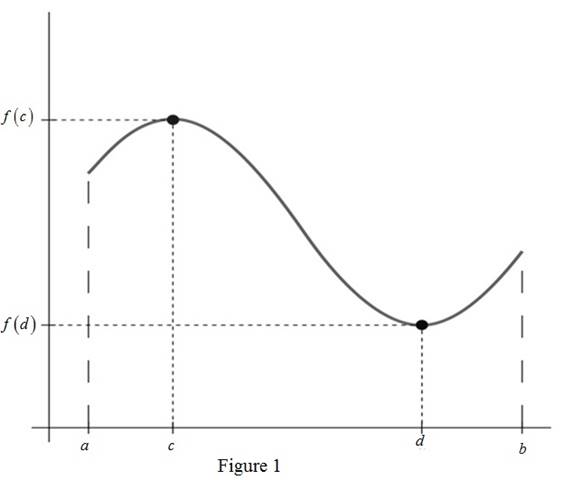
Concept explainers
(a)
To explain: The Extreme value theorem.
(a)
Explanation of Solution
The extreme value theorem is stated as follow.
Extreme Value Theorem:
“If f is a continuous function on
From the following Figure 1, the meaning of extreme value theorem can be easily understood.

In the Figure 1 the function f is defined on a closed interval
(b)
To explain: The working of Closed interval method.
(b)
Explanation of Solution
Closed interval method is an algorithm that is used to find the absolute minimum and the absolute maximum of a function over a closed interval
It consists of following three steps.
Step 1: Find the values of function f at the critical points in
Step 2: Find the values of function f at the end points of the interval
Step 3: Largest of the values from step 1 and step 2 is the absolute maximum value and lowest one is absolute minimum value.
Apply the closed interval method to find the absolute maximum and minimum of a function as illustrated in following example.
Example:
The absolute maximum and absolute minimum of the function
Calculation:
Obtain the first derivative of the given function.
Set
Here, the critical number
Step 1: Find the values of function f at the critical points in
Here the critical point is
Step 2: Apply the extreme values of the given interval in
Substitute
Substitute
Step 3:
Since the largest functional value is the absolute maximum and the smallest functional value is the absolute minimum, the absolute maximum of
Therefore, the absolute maximum value of
Chapter 4 Solutions
Single Variable Calculus: Concepts and Contexts, Enhanced Edition
- A 20 foot ladder rests on level ground; its head (top) is against a vertical wall. The bottom of the ladder begins by being 12 feet from the wall but begins moving away at the rate of 0.1 feet per second. At what rate is the top of the ladder slipping down the wall? You may use a calculator.arrow_forwardExplain the focus and reasons for establishment of 12.4.1(root test) and 12.4.2(ratio test)arrow_forwarduse Integration by Parts to derive 12.6.1arrow_forward
- Explain the relationship between 12.3.6, (case A of 12.3.6) and 12.3.7arrow_forwardExplain the key points and reasons for the establishment of 12.3.2(integral Test)arrow_forwardUse 12.4.2 to determine whether the infinite series on the right side of equation 12.6.5, 12.6.6 and 12.6.7 converges for every real number x.arrow_forward
- use Corollary 12.6.2 and 12.6.3 to derive 12.6.4,12.6.5, 12.6.6 and 12.6.7arrow_forwardExplain the focus and reasons for establishment of 12.5.1(lim(n->infinite) and sigma of k=0 to n)arrow_forwardExplain the focus and reasons for establishment of 12.5.3 about alternating series. and explain the reason why (sigma k=1 to infinite)(-1)k+1/k = 1/1 - 1/2 + 1/3 - 1/4 + .... converges.arrow_forward
 Calculus: Early TranscendentalsCalculusISBN:9781285741550Author:James StewartPublisher:Cengage Learning
Calculus: Early TranscendentalsCalculusISBN:9781285741550Author:James StewartPublisher:Cengage Learning Thomas' Calculus (14th Edition)CalculusISBN:9780134438986Author:Joel R. Hass, Christopher E. Heil, Maurice D. WeirPublisher:PEARSON
Thomas' Calculus (14th Edition)CalculusISBN:9780134438986Author:Joel R. Hass, Christopher E. Heil, Maurice D. WeirPublisher:PEARSON Calculus: Early Transcendentals (3rd Edition)CalculusISBN:9780134763644Author:William L. Briggs, Lyle Cochran, Bernard Gillett, Eric SchulzPublisher:PEARSON
Calculus: Early Transcendentals (3rd Edition)CalculusISBN:9780134763644Author:William L. Briggs, Lyle Cochran, Bernard Gillett, Eric SchulzPublisher:PEARSON Calculus: Early TranscendentalsCalculusISBN:9781319050740Author:Jon Rogawski, Colin Adams, Robert FranzosaPublisher:W. H. Freeman
Calculus: Early TranscendentalsCalculusISBN:9781319050740Author:Jon Rogawski, Colin Adams, Robert FranzosaPublisher:W. H. Freeman
 Calculus: Early Transcendental FunctionsCalculusISBN:9781337552516Author:Ron Larson, Bruce H. EdwardsPublisher:Cengage Learning
Calculus: Early Transcendental FunctionsCalculusISBN:9781337552516Author:Ron Larson, Bruce H. EdwardsPublisher:Cengage Learning





